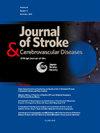The stroke meta-metric, Defect-Free Care, was maintained year-over-year within the Florida stroke registry during the COVID-19 pandemic
IF 2
4区 医学
Q3 NEUROSCIENCES
Journal of Stroke & Cerebrovascular Diseases
Pub Date : 2025-02-01
DOI:10.1016/j.jstrokecerebrovasdis.2024.108179
引用次数: 0
Abstract
Background
Resource allocation for stroke care was impacted worldwide by the Coronavirus 2019 (COVID19) pandemic. Regionally, worsened stroke outcomes varied, however comparative year-over-year in-hospital performance metrics from the pandemic are unreported. Therefore, within the large Florida Stroke Registry (FSR), we assessed the pandemic's effects upon the American Heart Association (AHA) Get With The Guidelines (GWTG) ischemic stroke metrics and the meta-metric, Defect-Free Care (DFC).
Methods
From March 2017 to February 2021, FSR collected 146,593 patients with a diagnosis of ischemic stroke or TIA (31,940 between 2017-2018; 35,086 between 2018-2019; 39,722 between 2019-2020; 39,845 between 2020-2021). FSR evaluated DFC, intravenous thrombolytic (IVT) use, endovascular therapy (EVT) use, and Door-To-Needle (DTN), Door-To-Computed Tomography (DTCT), and Door-To-Puncture (DTP) times.
Results
Pre-pandemic versus pandemic stroke patients’ demographics were similar (49.0 % vs. 48.6 % female, age 70.7±14.3 vs. 70.5±14.1 years, 64.0 % vs. 65.3 % white, 18.6 % vs. 18.8 % black, 17.4 % vs. 16.0 % Hispanic). Pandemic strokes, versus the immediate year pre-pandemic, were significantly more severe (median NIHSS 4 [IQR 8] vs. 3 [7]), utilized emergency medical services more (59.2 % vs. 57.6 %) and were more likely to receive EVT (8.0 % vs. 7.0 %). IVT use, and DTCT and DTP times were unchanged. The meta-metric DFC improved year-over-year, albeit slower during the pandemic [2017/18-2018/19: 70.7 % to 74.9 % (+4.2 %); 2018/19-2019/20: 74.9 % to 82.1 % (+7.2 %); 2019/20-2020/21: 82.1 % to 85.2 % (+3.1 %)].
Conclusions
Despite pandemic challenges, the stroke meta-metric DFC improved, albeit more slowly than pre-pandemic years. In this large statewide registry, pandemic patients received EVT more, potentially due to more severe stroke presentations. Stroke care infrastructure preparedness for future pandemics is warranted.
在 COVID-19 大流行期间,佛罗里达州中风登记处的中风元指标 "无缺陷护理 "逐年保持不变。
背景:2019冠状病毒(covid - 19)大流行影响了全球卒中护理资源分配。在不同地区,恶化的中风结果各不相同,但未报告大流行期间医院的年度比较绩效指标。因此,在大型佛罗里达卒中登记处(FSR)中,我们评估了大流行对美国心脏协会(AHA)获得指南(GWTG)缺血性卒中指标和元指标无缺陷护理(DFC)的影响。方法:2017年3月至2021年2月,FSR收集了146,593例诊断为缺血性卒中或TIA的患者(2017-2018年为31,940例;2018-2019年期间35,086;2019-2020年39,722人;2020-2021年期间39,845)。FSR评估DFC、静脉溶栓(IVT)、血管内治疗(EVT)、门到针(DTN)、门到计算机断层扫描(DTCT)和门到穿刺(DTP)时间。结果:大流行前与大流行期卒中患者的人口统计学相似(女性49.0%对48.6%,年龄70.7±14.3岁对70.5±14.1岁,白人64.0%对65.3%,黑人18.6%对18.8%,西班牙裔17.4%对16.0%)。与大流行前一年相比,大流行中风明显更严重(NIHSS中位数为4 [IQR 8]对3[7]),更多地利用紧急医疗服务(59.2%对57.6%),更有可能接受EVT(8.0%对7.0%)。IVT、DTCT、DTP均无变化。元指标DFC同比有所改善,尽管在大流行期间有所放缓[2017/18-2018/19:70.7%至74.9% (+4.2%);2018/19-2019/20: 74.9% - 82.1% (+7.2%);2019/20-2020/21: 82.1%至85.2%(+3.1%)。结论:尽管面临大流行的挑战,卒中DFC仍有所改善,尽管速度较慢。在这个大型登记中,大流行患者接受EVT更多,可能是由于更严重的卒中表现。卒中护理基础设施/应对未来流行病的准备是必要的。
本文章由计算机程序翻译,如有差异,请以英文原文为准。
求助全文
约1分钟内获得全文
求助全文
来源期刊

Journal of Stroke & Cerebrovascular Diseases
Medicine-Surgery
CiteScore
5.00
自引率
4.00%
发文量
583
审稿时长
62 days
期刊介绍:
The Journal of Stroke & Cerebrovascular Diseases publishes original papers on basic and clinical science related to the fields of stroke and cerebrovascular diseases. The Journal also features review articles, controversies, methods and technical notes, selected case reports and other original articles of special nature. Its editorial mission is to focus on prevention and repair of cerebrovascular disease. Clinical papers emphasize medical and surgical aspects of stroke, clinical trials and design, epidemiology, stroke care delivery systems and outcomes, imaging sciences and rehabilitation of stroke. The Journal will be of special interest to specialists involved in caring for patients with cerebrovascular disease, including neurologists, neurosurgeons and cardiologists.
 求助内容:
求助内容: 应助结果提醒方式:
应助结果提醒方式:


